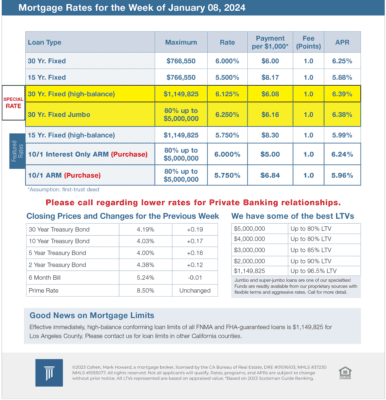Mixed Economic Data Causes Rate Bump
After dropping sharply during the final two months of the year, mortgage rates moved a little higher during the first week of 2024. A large batch of major economic data released during last week revealed mixed results.
Job Gains and Losses
In December, the economy added 216,000 jobs, above the consensus forecast of 160,000, but the results for prior months were revised lower by 71,000. The largest gains were seen in health care, government, and leisure/hospitality, while the transportation/warehousing sector posted losses.
Unemployment Rate Unchanged
The unemployment rate remained unchanged at 3.7%, below the consensus of 3.8%. Average hourly earnings increased 0.4% from November, slightly above the consensus forecast. Earnings were 4.1% higher than a year ago, up from an annual rate of increase of 4.0% last month. Fed officials keep a close eye on wage growth because it generally raises future inflationary pressures.
Strong Employment Report
While the Employment report was a bit stronger than expected overall, the JOLTS (job openings and labor turnover rates) data suggested easing conditions in the labor market. At the end of October, there were 8.8 million job openings, the fewest since March 2021. In addition, the “quits” rate was just 2.2%, down from about 3.0% at the end of 2021. Since people generally are more willing to voluntarily leave their jobs when they are confident about finding a better one, a lower quits rate is consistent with a looser labor market. Similarly, a lower number of openings suggests companies face less pressure to raise wages to hire enough workers.
Strong Consumer Preference for Services Over Goods
Two other significant economic reports released last week from the Institute of Supply Management revealed contrasting results. The ISM national services sector index was 50.6, while the national manufacturing index was just 47.4, close to the lowest level since May 2020. Since readings above 50 indicate an expansion in the sector and below 50 a contraction, this data continues to highlight the consumer preference for services over goods this year. Also notable, this was the fourteenth straight month of readings below 50 for the manufacturing sector, the longest streak in about 15 years.
Major Economic News Due This Week
Investors will continue to watch for Fed officials to elaborate on their plans for future monetary policy. For economic reports, the Trade Deficit will come out on Tuesday. The Consumer Price Index (CPI) will be released on Thursday. CPI is a widely followed monthly inflation indicator that looks at the price changes for a broad range of goods and services.

Mortgage Rates for the week of 1-08-2024
